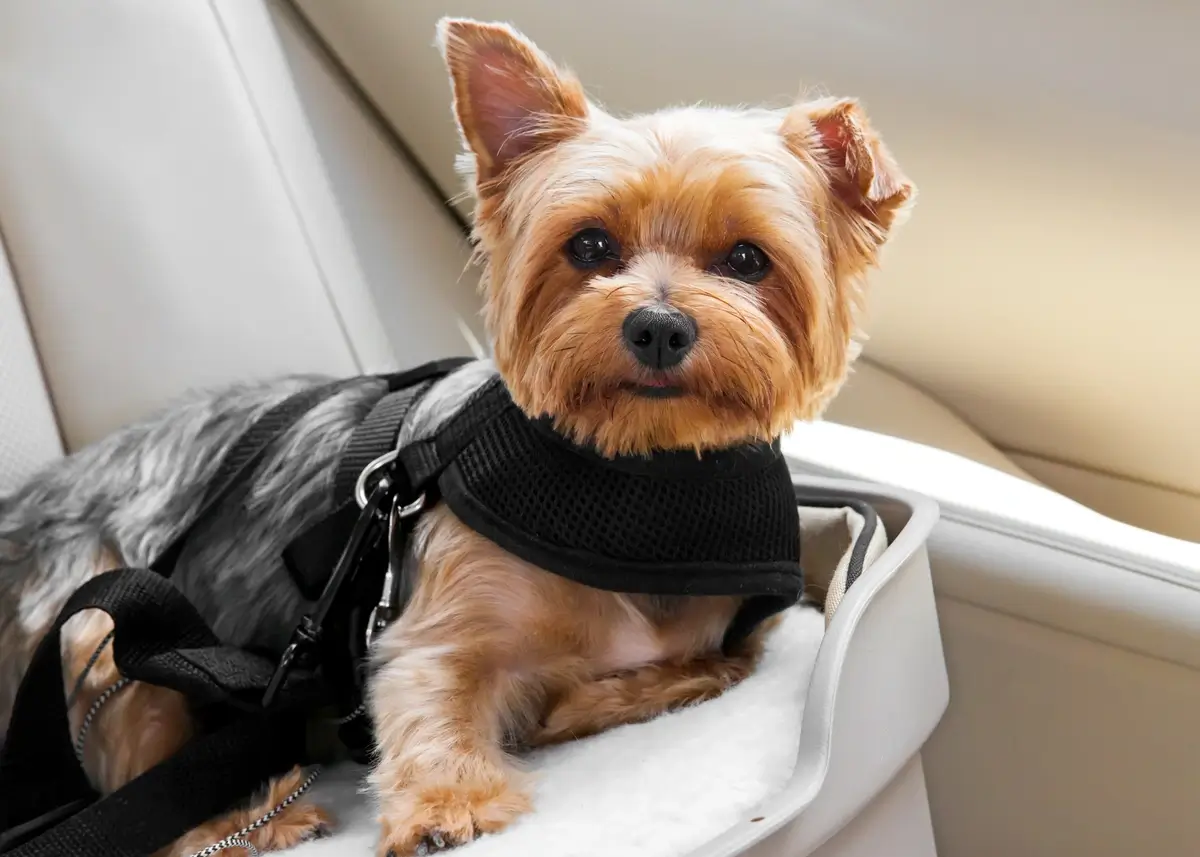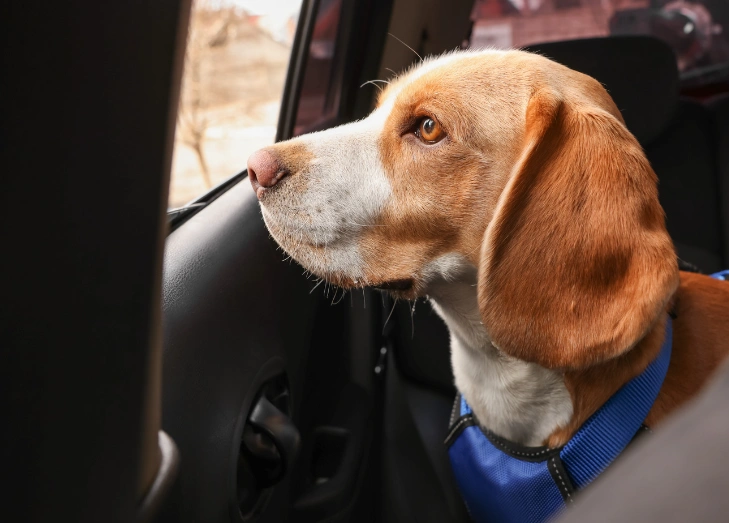In Part 1 of this series on car safety for dogs, we discussed the challenges drivers face on the road with their puppies, car safety for dogs to help you learn statistics on distracted driving, attitudes about pet safety in vehicles, and causes of accidents with pets in cars.
Today we’re going to talk about how to get your dog comfortable in the car, safety tips, and products you can use during a car trip to keep your puppy safe.
How Often Do Dogs Ride in Cars?
The answer should be at least twice a year to regularly scheduled vet visits (unless you’re able to take a walk to the vet). With an estimated 65.1 million U.S. households owning a dog, that’s a lot of car rides!
“It’s just a short trip”
A survey conducted by the NHSTA reports that more than 85% of pet parents say trips are under 25 miles, and 68% say they're 10 miles or shorter. They also noted that most accidents occur within 25 miles of home.
The majority of pet owners who claimed their trips are short eerily corresponds to the fact of how many miles most accidents occur, doesn’t it? How convenient! Pet parents cannot use the excuse of slacking on pet safety because they falsely believe they are safer staying close to home. This makes it even more important to have people’s opinions of safe driving match their actual habits.
Let’s turn to a survey from the AAA and Kurgo to examine answers to driving habits with dogs in the vehicle.
- Nearly six in 10 (56%) respondents have driven with their dog in a vehicle at least once a month over the past year, according to the AAA/Kurgo survey.
- Eighteen percent of respondents who drive with a dog in the vehicle also have children under the age of 13 who ride with them. Seven in 10 of these motorists have driven with a child and an unrestrained dog in the vehicle at the same time.
- Three in 10 (29%) of respondents have heard stories of car crashes where unrestrained dogs riding in the car were injured or caused injury to people in the car. Of the respondents who have heard these stories, four in 10 (39%) said this impacted their decision about using a pet restraint.
Unsafe driving conditions
In Part 1, we discussed reasons why people are distracted driving with dogs in cars and the dangers certain actions can cause.
- Three in 10 respondents (29%) admit to being distracted by their dog while driving.
- Sixty-five percent of dog owners admit to engaging in at least one potentially distracting activity while driving with their dog
Strategies For Safe Driving Practices With Dogs
Let’s talk about strategies for how to ride with your dog safely in a car. There are certain actions you can take before your dog even climbs up into the car for the promise of a Pup Cup all the way to flying down a highway at a safe, posted high speed.
Get your dog used to the car
Puppies must be taught how to ride in a car and associate it with great experiences before they only think the car means a vet trip. Creating that connection that a car ride equals fun is a crucial step in teaching proper riding manners to your puppy.
The key to success is taking it slow. Begin with very short car trips, like just sitting in the car with the engine off and the dog in the backseat. Gradually increase the duration of these sessions.
Make the car a fun place. Bring your dog's favorite toys or treats and play with them in the car. This creates positive associations with the vehicle. If your dog is prone to motion sickness, skip any ingestible treat and stick to toys and praise instead.
Once your dog is comfortable sitting in the stationary car, start the engine without moving. If your dog remains calm, give them treats and praise.
Upchuck in motion
Dog vomit can be a very unpleasant situation for both you and your puppy. If your puppy gets carsick, they may yerp and burp their way to your destination, spilling their contents all over your car (and hopefully not you). The good news is there are actions you can take to help your puppy on your journey. Talk to your vet if you need medication or other techniques to reduce motion sickness in dogs. They may recommend a prescription or over-the-counter medication to be given before your car trip.
Always have a stocked cleaning kit with non-toxic, pet-friendly ingredients to take care of any messes along the way. Trust us – you won’t want to get caught with nothing but a used napkin in the car to clean up!
Puppy security
Never leave your puppy unattended with strangers, even for a moment. Puppy-napping is a real concern. Keep a tight leash on your pup, as they can dart away or accidents can happen when others are handling them. Prioritize your puppy's safety and trust only those you know.
Likewise, never leave your puppy in the car alone, even if you have a car that you can control the locks, air conditioning or heat, or ignition when outside the car.
Observe your puppy
Sometimes you have no choice but to be in the car with your puppy and do your best to make the journey. However, it’s still important to observe your puppy’s canine body language and behavior to see if they are anxious, stressed, or afraid. You may have to end your adventure with your puppy early and try again another day.
Patience and defensive, present driving
When traveling with dogs, you have to keep patience above all. A journey can truly turn into an adventure when riding with a puppy. Keep your feelings under control when situations escalate with a puppy in the car, especially when operating a vehicle with loved ones inside.
You should also practice patience on the road. Follow all posted speed limits. Do not tailgate, switch lanes suddenly, or express any form of road rage. Leave in plenty of time so you are not rushed. Do not check your phone or play around with your console while driving since it only takes a few seconds of distracted driving to get in a crash. Slow down when coming around curves or turning. Pull over to a safe spot and check on your puppy rather than try to mitigate a situation while driving. When you practice safe driving habits, you will reduce the chances of a crash or having to brake suddenly.
Options for Safe Dog Travel
When financially preparing for a puppy, part of that cost will be purchasing proper travel equipment for dogs. The Center For Pet Safety recommends certain certified products based on independent crash tests. Check them out and pick the best one for you.
Traveling with your dog can be a rewarding experience, but ensuring their safety is paramount. The AAA/Kurger survey above found of the 16 percent who use a pet restraint, the most frequently used are:
- Pet harness/safety belt (56%)
- Hard-sided pet travel crate (30%)
- Pet vehicle seat (10%)
- Vehicle pet barrier (8%)
- Soft-sided pet travel crate (7%)
- Other (5%)
You should discuss with your veterinarian the option you feel is right for your puppy regarding their dog breed, weight and height, and any other pertinent factors.
- Dog Harness: A dog harness designed for car travel can be an excellent choice. It attaches to the seatbelt, keeping your dog safely in the back seat while allowing them some freedom of movement.
- Dog Seat Belt: Dog seat belts connect your dog's harness to the car's seatbelt system, preventing them from moving around the car while keeping them safe.
- Dog Crate: A dog crate in the car provides a familiar and secure space for your dog. Make sure it's securely anchored to prevent movement during sudden stops or turns.
- Pet Car Barrier: If your dog prefers a little more space, consider using a pet car barrier. These mesh or metal barriers separate the back seat from the rest of the car, ensuring your dog stays secure in the rear area.
- Travel Dog Bed or Dog Car Seat: Some dogs prefer elevated seats or dog car beds with seatbelt attachments. These options offer comfort and safety simultaneously.
Safely Transport a Pawrade Puppy
For our two-part series on vehicle safety for dogs, we hope you’ve thought about pet safety in cars that you might not have known about.
We partner with trustworthy dog breeders to offer healthy puppies for sale with their safety, security, and happiness at the forefront of what we do. We hope you select a canine companion to keep safe on all your adventures!



